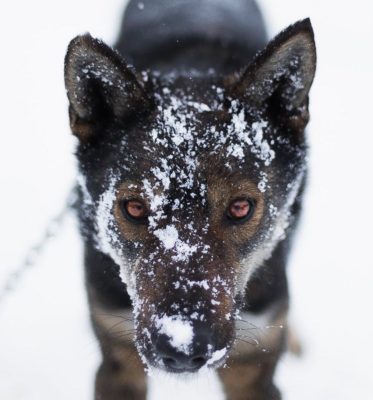How Cold is too Cold?

#CAATCommunityCorner
How cold is too cold?
There are several factors to consider for your dog when determining what is safe and comfortable for them to handle in regards to colder temperatures (single digits).
The length of time they can tolerate being outdoors depends on what their breed type is naturally suited to endure and other factors…
- The length and thickness of a dog’s fur is one of the biggest factors in increasing their tolerance for cold weather. Dogs with thick double coats (husky types) can tolerate (and often enjoy) colder weather, as long as they have shelter from wet and wind. Fur is their insulation. Many purebred or mixed breed dogs are not blessed with thick, double layered winter fur. These dogs also don’t have the extra fur around their pads of their feet either. They do not have the ability to tolerate the cold. For them, going outside is like you walking outside in a T-shirt. They can’t tolerate the cold.
- Wind chill, cloud cover and dampness can affect a dog’s fur ability to insulate so remember that as well. Sunshine helps to provide some warmth but if it is windy and cloudy or rainy, they just won’t stay warm enough outside.
What happens if they get too cold?
Dogs that get too cold are in danger of a life threatening condition called hypothermia. It is the result of prolonged exposure to cold temperature or getting wet fur and skin in cold temperatures. Very young dogs, small dogs, skinny dogs, ill dogs and old dogs are all more susceptible to hypothermia.

Signs of Hypothermia:
- shivering
- paleness of skin (look at their gums)
- lethargic or seeming tired
- shallow breathing
- weakness
- muscle stiffness
- eventually they will go into a coma and die if left untreated
What do you do if you see your dog showing early signs of hypothermia?
- Warm some blankets in the clothes dryer or with a hair dryer and wrap the dog in them
- Wrap a hot water bottle or a water or milk jug with hot water in it in a towel and place it against the dog’s tummy (DO NOT USE IT UNWRAPPED, IT CANNOT GO AGAINST BARE SKIN AS IT COULD BURN THE SKIN)
- IF you have a thermometer, check the dog’s temperature (insert it into rectum and read every 10 minutes). If it is below 98°F (36.7°C), and you are able to in any way, seek immediate veterinary attention. However, we understand that many of our remote and rural community members don’t have access to the veterinarian so just do your best to keep warming your dog up with the above recommendations.
- Once the temperature is above 100°F ( 37.8°C), you ca
 n remove the hot water bottle to avoid overheating. Keep the dog in a warm room.
n remove the hot water bottle to avoid overheating. Keep the dog in a warm room. - If you don’t have a thermometer (not unusual for many) then just keep warming up until you start to see that your dog is responding to you, awake, walking around and behaving normally.
- In severe cases where the dogs temperature is not able to be brought back up, without veterinary attention they may not be able to recover, however, do the best that you can to save them.
Prevention is KEY!
Remember, regardless of coat length, thickness, weather, etc. all dogs need a warm, dry place to go to during the winter season. Basically, when the temperature outside is too cold for you to be out long without a coat, mitts, hat, boots, etc. it is too cold for these dogs. On days like this, just letting them go to the bathroom outside quickly and bringing them right back in is about all they can safely handle.




